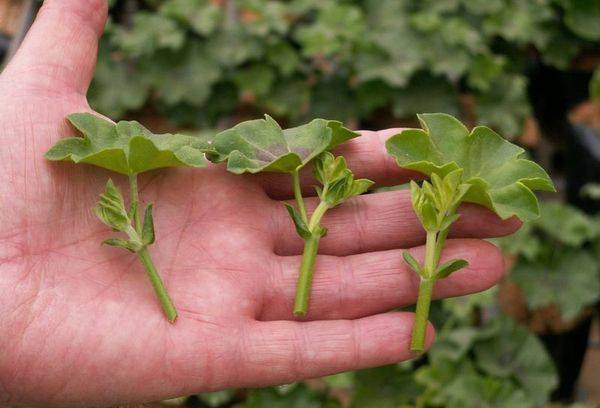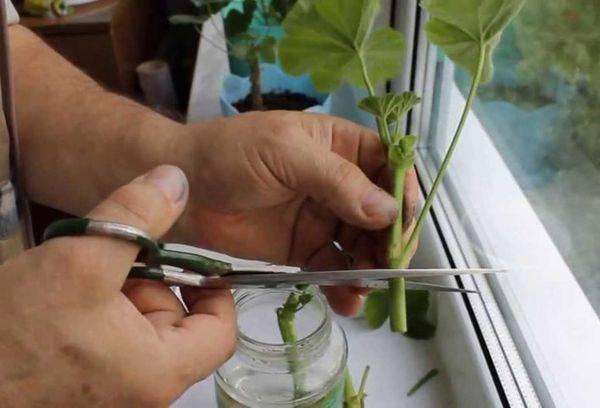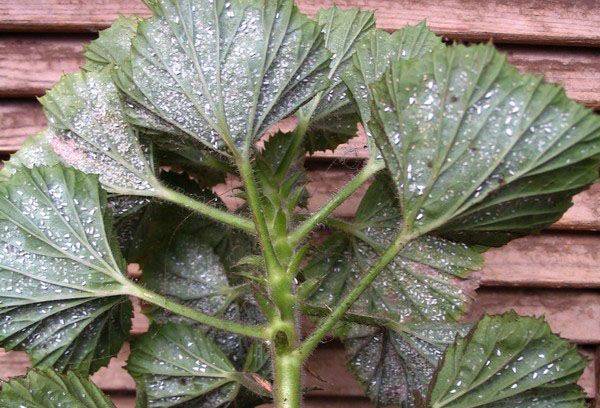How to properly care for royal pelargonium
A plant with a magnificent appearance, and therefore a real favorite among gardeners, is geranium or, more scientifically, royal pelargonium. This is a flower native to South America. It came to Europe in the 18th century, and since then, breeders have developed many different varieties, differing in appearance and characteristics.
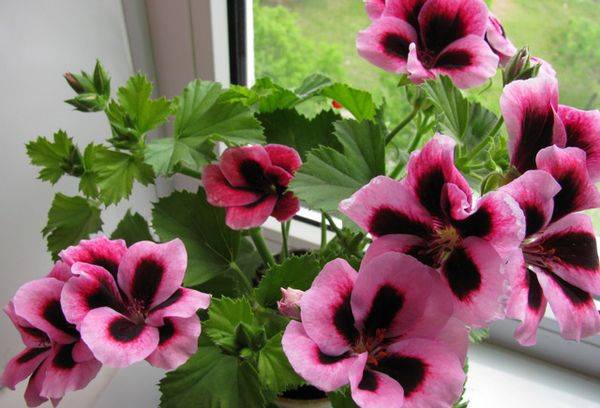
Description
Pelargonium royale as a botanical species is called grandiflora and belongs to the Geraniaceae family.
Interesting fact
Geranium and pelargonium are different plants, but very often, when flower growers call a flower geranium, they mean pelargonium.
The pelargonium bush is small in size and reaches up to 60 cm. The stems are herbaceous, erect, completely covered with dark green leaves with a rough surface and a small fluff. The plant is distinguished by large inflorescences, which, with good care, can be up to 25 cm in diameter. It is for this reason that pelargonium is valued.
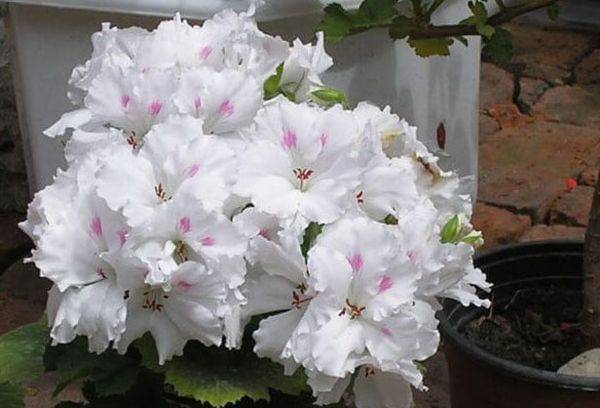
Pelargonium Mona Lisa
One flower is approximately 5-7 cm in diameter, the petals located on top are superimposed like a fan on the lower ones, while their color and shape are varied: they can be lilac, violet, white or painted in almost any shade of red. One bud can include several contrasting tones. The shape of the flowers is regular and double (most often), with corrugated, smooth or wavy edges, and practically no smell.
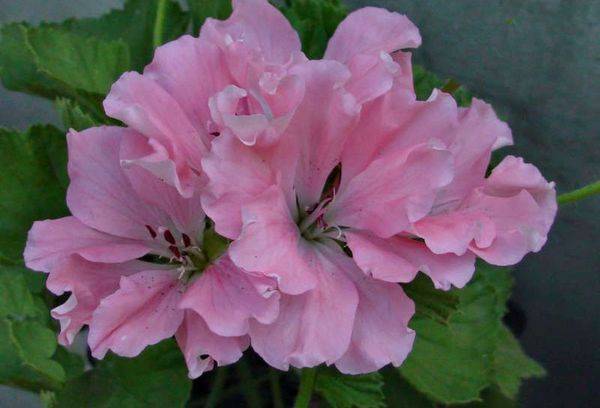
Pelargonium Pink Mikado
Pelargonium Regal looks equally beautiful in a pot on the wall or displayed on a windowsill. During the summer months, the plant is often planted on the balcony. With proper care and feeding, royal pelargonium blooms within three to four months. Other types of geraniums bloom much longer; in order to achieve the same from the queen, constant pruning of dried buds and the application of mineral fertilizers, which include phosphorus and potassium, are needed. As a means of extending the flowering period, grafting of royal pelargonium onto other varieties of this flower is used.
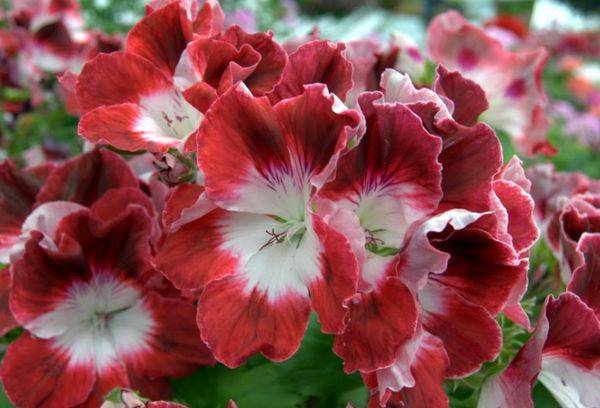
Pelargonium Regal
Varieties
Breeders have bred many varieties of royal pelargonium, but only a few of them are especially loved by flower growers:
- Pink Mikado — the flowers are very large, pink, the petals have a wavy edge.
- Carisbrooke - plants with light pink flowers, on the upper petals there is a marble pattern in the form of strokes and spots.
- Nellie - petals are wavy, dark red and white, flowers are semi-double.
- Aristo Schoko - the flowers are large, with very dark petals (red, almost black), along their edge there is a border that is one or two shades lighter than the main color.
- Sally Munro - the variety is capable of blooming several times per season, is distinguished by large flowers, the lower petals are pinkish, the upper ones are dark red.
- Mona Lisa - plants with large white flowers with pink stamens, petals with wavy edges.

Pelargonium Mona Lisa
Home care
Royal pelargonium is a rather demanding plant in terms of growing conditions, and growing it at home is not an easy task. Violation of the rules of care is fraught with the cessation of flowering.The flower does not grow well in the shade, and direct sunlight leads to burns on the delicate velvety leaves. Insufficient and excessive watering have equally detrimental effects on the condition of the plant.
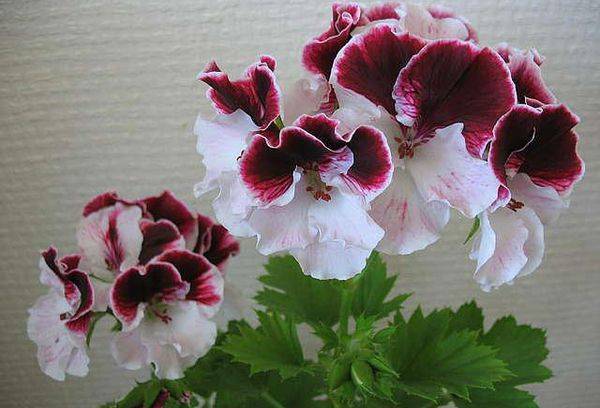
Pelargonium Sally Munro
Illumination. If the plant receives enough light, the flowering will be long and abundant. The flowerpot can be placed on the windowsill of a window facing south, but it is necessary to protect the flower from direct rays of the sun.
Advice
In the winter months, supplement the plant with phytolamps. This will prevent the stems from stretching due to lack of light.
Temperature regime. In summer, the thermometer in the room where the royal pelargonium is located should not rise above +24° C. In winter, the flower is in a dormant state, for which the optimal regime will be from +12 to +15° C. Draft is unacceptable. If you neglect these rules, pelargonium will not bloom.
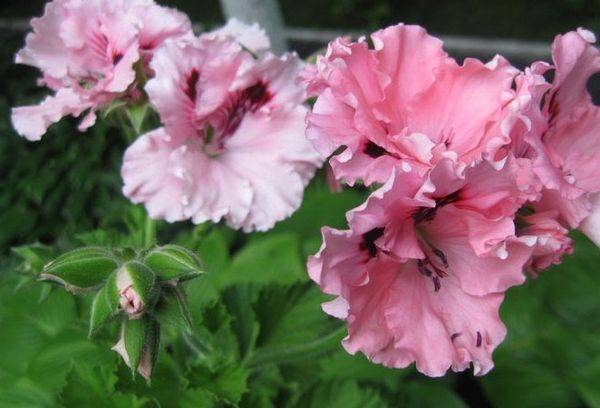
Pelargonium Carisbrooke
Humidity. This indicator is not very important. Pelargonium tolerates dry and humid atmospheres well, but when spraying (if the air in the room is very dry), it is necessary to avoid getting droplets of water on the flowers and leaves.
Advice
Pelargonium loves fresh air very much, so in the summer be sure to take it outside or onto the balcony. This will ensure an excellent appearance of the plant, longer and more abundant flowering.
Watering. In the summer months, royal pelargonium needs to be watered generously twice a week; if it is hot, this should be done every other day, and in some cases daily. The main criterion by which the need for watering is determined is the dried top layer of soil.
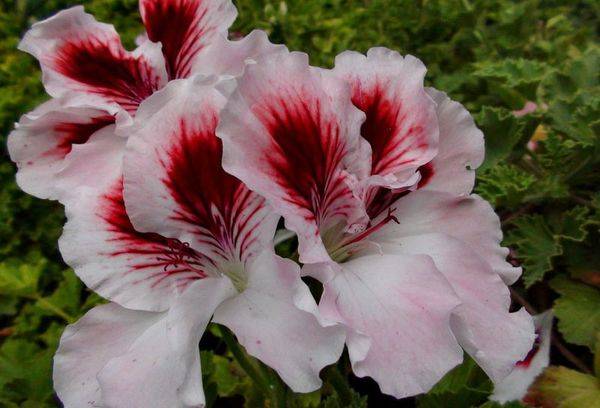
Pelargonium Nellie
The magazine purity-en.htgetrid.com recommends watering the plant with well-settled water (at least 12 hours), not in a flowerpot, but in a tray. Boiled water will do.
Feeding. In spring and summer, when the plant blooms, it is necessary to apply complex mineral fertilizers with a high content of phosphorus and potassium once every two weeks. This will extend the flowering period by several weeks. Royal pelargonium will like fertilizers designed specifically for indoor plants, for example, “For flower plants” or “Merry flower girl”. If there is too much nitrogen in the complex fertilizer, then the stems and leaves will grow well, and fewer buds will form. There is no need to fertilize in winter.
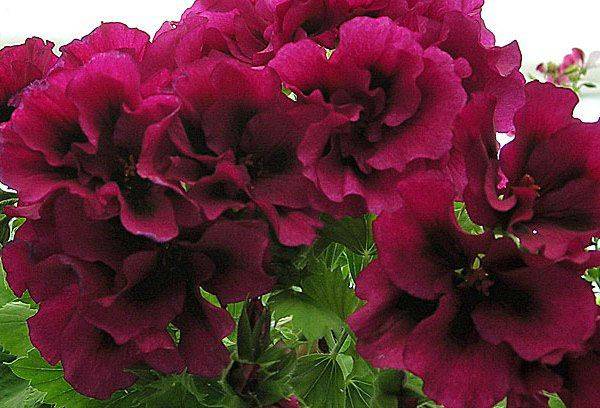
Pelargonium Aristo Schoko
Priming. It is necessary to place a drainage layer at the bottom of the pot, which will ensure the removal of excess liquid, preventing stagnation of water. The substrate must have a slightly alkaline or neutral reaction.
Advice
Regular ash will help reduce acidity - pour a little of it into a flowerpot. In addition to the alkalizing effect, ash will be a good fertilizer.
Proper care ensures that royal pelargonium blooms for several months every year.
Reproduction and transplantation
Royal pelargonium is most often propagated by cuttings, since seeds are not easy to find even in online stores. In addition, the characteristics of the terry nature of the most beautiful flowers are not transmitted through seed propagation. The best period to root cuttings of royal pelargonium is September and August, but this can be done all year round.
Cut the cutting at an angle of 45 degrees, 5 mm below the internodes; for dwarf and small plants its length should be approximately 5 cm, for large, tall plants - 10 cm. Remove the lower leaves and buds from the shoots, leaving only the top three. Sprinkle the cutting area with charcoal (crushed) and let the cutting lie in the air for 18 to 24 hours.
Let's assume another method of rooting. 10 minutes after the cutting was cut from the bush, carry out the following activities:
- treat the cuttings with root;
- plant in a mixture consisting of peat, humus and sand or in wet peat tablets;
- cover with non-woven cloth for three days.
Cuttings should not be placed in ordinary water for rooting: they will rot or not sprout roots. Young sprouts need moderate watering, as they are sensitive to excess moisture.
Advice
Water the planted cuttings with phytosporin. This technique will prevent the development of rot on the cuts.
Rooting should occur at a temperature of +19 to +23° C. The roots will appear in a maximum of 12 weeks, after which plant the cuttings in a pot where the plant will be grown permanently. Above the third pair of leaves, pinch the main stem, this will ensure the growth of new side shoots. With proper care of young plants, the first inflorescences will appear next spring.
The aerial part grows at a very fast pace in all pelargoniums, regardless of the species. Over the summer, with good care, the bush and roots will noticeably lengthen. If, when removing the earthen lump from the pot, it is clear that the roots have completely entwined the soil, then replant the pelargonium in February. The soil should retain moisture, have excellent air permeability and be loose. The ideal soil mixture would be sand, garden soil and peat taken in equal parts.
Stagnation of water in a pot provokes root rot; to prevent this problem from occurring, place a thick layer of drainage on the bottom of the container.
Advice
Do not plant royal pelargonium in containers that are too wide, otherwise the buds may not appear. The fact is that in a large pot, pelargonium actively grows green mass.
Useful tips
When growing royal pelargonium, problems most often arise with excess moisture due to excessive watering.
Recommendations from experienced flower growers will help to detect the problem in a timely manner and eliminate it:
- If the leaves located below turn yellow, the reasons may be different. The elasticity of the sheet plates does not change, but the edges dry out due to lack of moisture. Limp and rotten leaves indicate overwatering. Leaf blades that have turned yellow at the edges indicate a lack of nutrients in the soil, which systematic feeding will help replenish.
- The leaves of pelargonium turn red if it freezes, so during the cold months of the year, remove the flower pot from the windowsill and place it at a distance from the window.
- The base of the stem darkens when the flower is infected with black stalk. It will not be possible to cure this disease or save the flower; it is necessary to destroy pelargonium as soon as possible to prevent the pathogen from spreading to other indoor plants.
- The leaves fall off and the stem becomes bare when the flower is insufficiently illuminated. Most often this happens in winter. To correct the situation, illuminate the pelargonium with a phytolamp.
- Watery soft pads appear on the leaf blades under the simultaneous action of two unfavorable factors: excess moisture and lack of light. Additional illumination with a phytolamp and a reduction in the number of waterings eliminate the problem.
- Pelargonium planted in open ground will not bloom if too much fertilizer has been added to the soil or if there is extreme heat. Move the flowerpot with the flower to partial shade and water more often. Stop feeding the plant, especially if no flowers appear, but pelargonium is growing very quickly.
- A plant located indoors most often does not bloom due to lack of light, excess fertilizing, and almost the same air temperature day and night. Stop fertilizing for some time, provide additional lighting, or move the pot to a more illuminated place.
- Pelargonium buds can dry out and fall off without even opening due to excessively high air humidity and excessive watering. Reduce the frequency or amount of soil moisture and provide a drier atmosphere.
